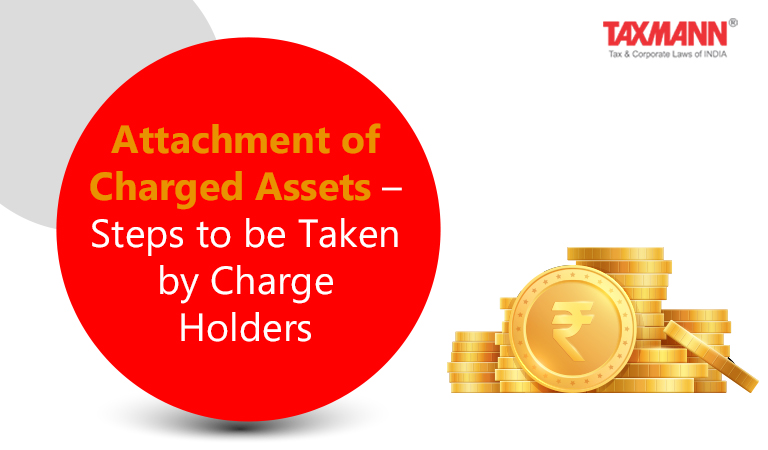Attachment of Charged Assets – Steps to be Taken by Charge Holders
- Blog|News|Company Law|
- 3 Min Read
- By Taxmann
- |
- Last Updated on 22 September, 2021

[2021] 130 taxmann.com 305 (Article)
Recently one of the significant modes of investments that have gained momentum in India has been capital raising by companies either through debt funding through portfolio management, borrowings through different financial institutions, and by other modes of borrowings. A characteristic secured debt financing/lending transaction is structured in a manner, such that the security or charge creation establishes the lender’s right over specified assets of the borrower for securing the repayment of the principal amount, interest, or any other special premium attached to the principal amount.
Quite often it is observed that such borrower entity further raises debt finance by approaching another lender or a financial entity, as a result of which the entity creates a second charge over the same assets of the entity in favor of the subsequent lender/creditor. Such “charge” stands as subordinate security to the charge created in favor of the first lender/creditor and the enforceability of such security during the existence of the first charge-holder seems a distant possibility.
Scope of Article:
In this article, the author has strained to establish and set out the pragmatic hindrances and challenges faced by subordinate charge-holders of an asset, secured for repayment of the debt by the debtor to such lender/charge-holder and the viable solution that may be adopted and incorporated in the legal regime to foster debt financing, especially syndicated lending, where various lenders finance an entity and secure its assets.
Remedies available and the challenges:
At the outset, as per the provisions contained under section 2(16) of the Companies Act, 2013 the term “charge” is defined as an interest or lien created on the assets or property of a company or any of its undertakings as security and includes a mortgage.
A lender generally derives its rights under Securitization and Reconstruction of Financial Assets and Enforcement of Security Interest Act, 2002 (SARFAESI Act), where a “financial institution” is entitled to enforce security interest, in addition to remedies available under the security documents. Similarly, a creditor/lender, as a “financial creditor” under the Insolvency and Bankruptcy Code, 2016 (IBC), is entitled towards the proceeds of the sale of the liquidation assets of a corporate debtor, in order of priority set out under the IBC. In addition to the above laws, the lender has a right to claim specific performance and recovery of amounts due under the security documents executed in relation to the debt.
Also, so far as the claims of the first charge-holder and the second charge-holder are concerned, in the event the debts are due to both, the law stands quite clear that the claim of the first charge-holder shall prevail over the claim of the second charge-holder and the same shall be realized from the immovable property belonging to the borrower entity and the amounts due to the first charge-holder shall be repaid in priority to the second charge-holder. Two of the landmark judgments that can be inferred in this regard from the dictum laid down by the Hon’ble Apex Court in the cases of ICICI Bank Ltd. v. SIDCO Leathers Ltd. [2006] 67 SCL 383 and Employees Provident Fund Commr. v. Official Liquidator of Esskay Pharmaceuticals Ltd. [2011] 15 taxmann.com 140/ 110 SCL 520.
However, the uncertainty lies in the law regarding the remedy of a second charge-holder, in the event the borrower entity has defaulted under the security documents executed with such second charge-holder, and where, in an ongoing debt, there has been no default by the borrower entity towards the first charge-holder and payment of principal amount and interest is complied with, though there is default by the borrower in making payments towards the second charge-holder and the second charge-holder desires to enforce the security. In a typical scenario, there is either an inter-creditor agreement between the first charge-holder and the second charge-holder or the first charge-holder provides a no-objection certificate to the corporate debtor regarding the creation of the second charge, and the same is agreed/acknowledged by the second charge-holder.
Click Here to Read the Full Article
Disclaimer: The content/information published on the website is only for general information of the user and shall not be construed as legal advice. While the Taxmann has exercised reasonable efforts to ensure the veracity of information/content published, Taxmann shall be under no liability in any manner whatsoever for incorrect information, if any.

Taxmann Publications has a dedicated in-house Research & Editorial Team. This team consists of a team of Chartered Accountants, Company Secretaries, and Lawyers. This team works under the guidance and supervision of editor-in-chief Mr Rakesh Bhargava.
The Research and Editorial Team is responsible for developing reliable and accurate content for the readers. The team follows the six-sigma approach to achieve the benchmark of zero error in its publications and research platforms. The team ensures that the following publication guidelines are thoroughly followed while developing the content:
- The statutory material is obtained only from the authorized and reliable sources
- All the latest developments in the judicial and legislative fields are covered
- Prepare the analytical write-ups on current, controversial, and important issues to help the readers to understand the concept and its implications
- Every content published by Taxmann is complete, accurate and lucid
- All evidence-based statements are supported with proper reference to Section, Circular No., Notification No. or citations
- The golden rules of grammar, style and consistency are thoroughly followed
- Font and size that’s easy to read and remain consistent across all imprint and digital publications are applied





